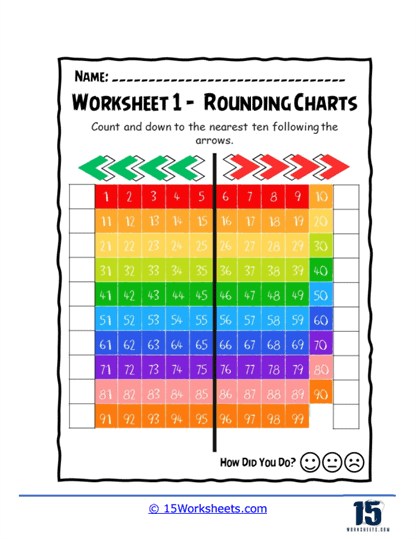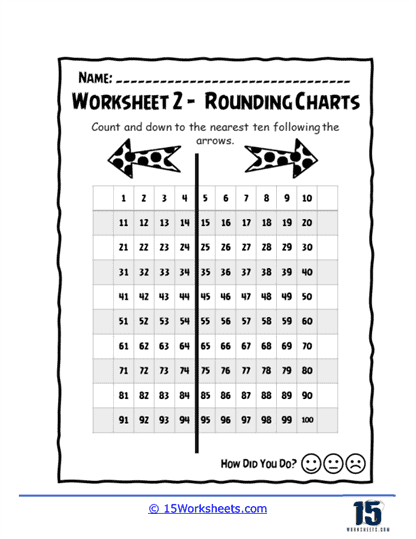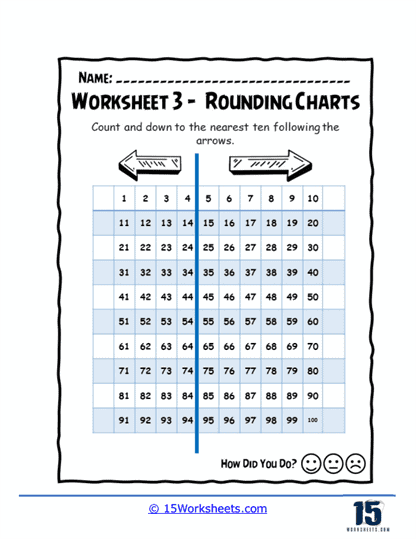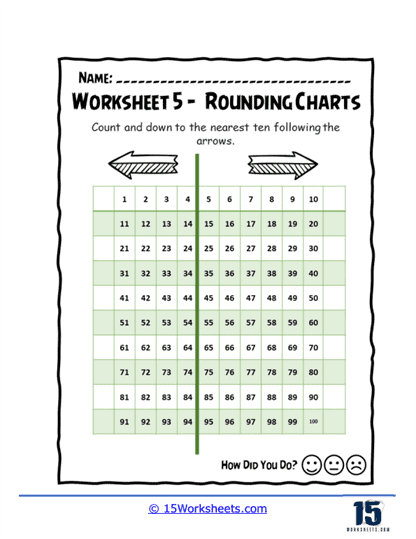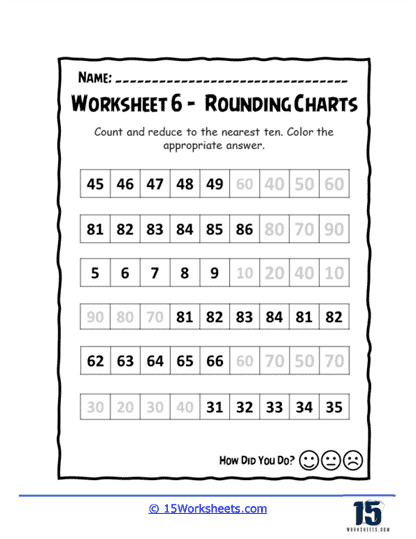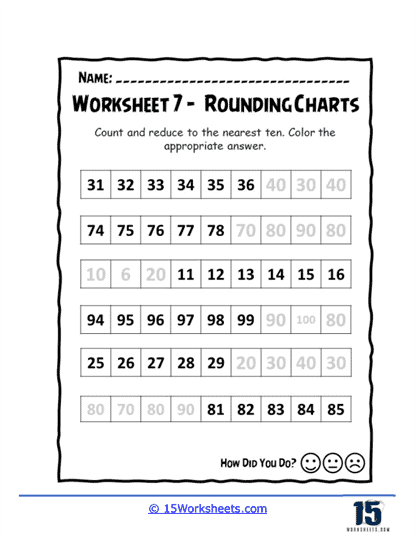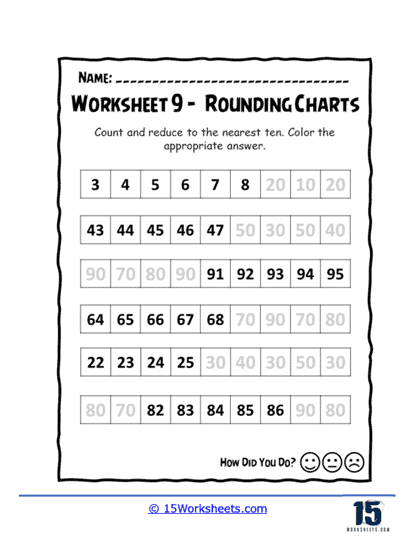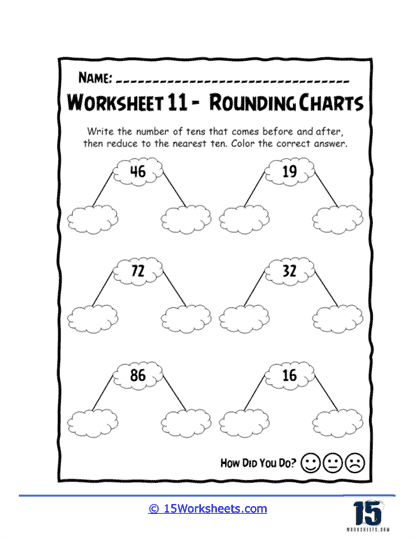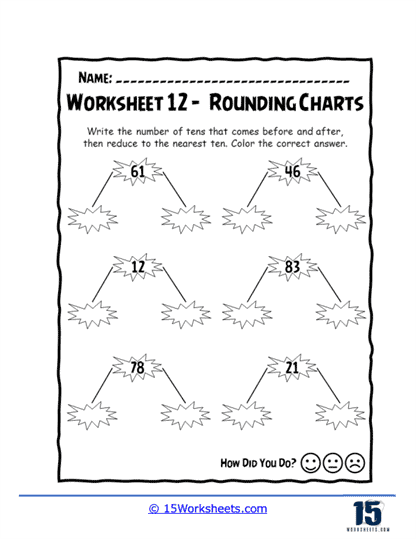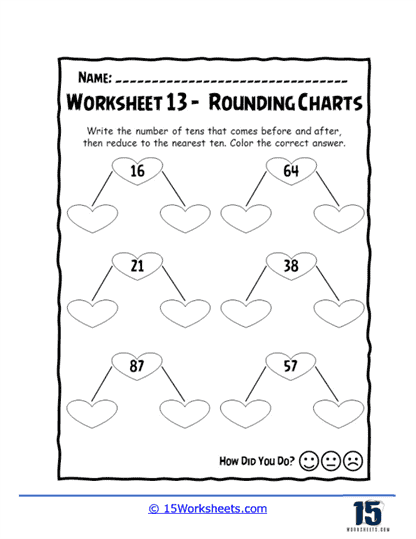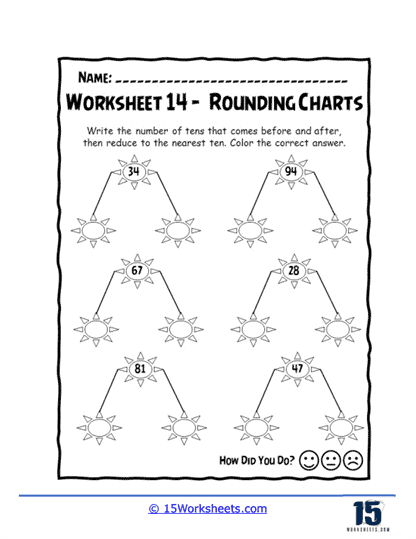Rounding Charts Worksheets
About These 15 Worksheets
These worksheets are tools designed to help students grasp the concept of rounding numbers, particularly to the nearest ten. These worksheets take on various forms but share a common goal: teaching children how to find the closest multiple of ten for given numbers. The concept of rounding helps students understand the basic principles of estimation, which is a key skill in both daily life and advanced mathematics. Let’s explore the different types of rounding charts worksheets, detailing their format, the types of exercises found within, and the specific math skills they help develop.
The first type of rounding chart often focuses on numbers between two tens. Students are presented with a number, and their task is to identify the tens that come before and after the given number. For example, if the number is 52, students would be prompted to recognize that 50 and 60 are the closest tens. Once they have identified the tens, the next step is to determine which one the number is closer to, rounding it accordingly. This kind of worksheet teaches place value skills and introduces the concept of distance on a number line. It also encourages children to think critically about proximity, which builds a foundational understanding of rounding principles. Additionally, students are asked to color the correct answer, making the activity more interactive and visually stimulating.
Another variation includes charts where students count up or down to the nearest ten. These worksheets often provide students with a grid of numbers, which they are required to follow along a path. Arrows might direct them to count either up or down to reach the nearest ten. In this exercise, students are not only practicing rounding but also reinforcing their counting skills and becoming more familiar with number sequences. These worksheets are effective in demonstrating how numbers naturally flow toward their nearest ten, further cementing the relationship between a number and its tens neighbors.
Some rounding worksheets challenge students to look at a number and instantly select the nearest ten from a list of options. These worksheets are designed to test the student’s quick-thinking abilities and improve their mental math skills. In this format, students may see numbers like 91, 62, or 23, and they must immediately recognize whether to round up or down. These kinds of worksheets place a stronger emphasis on speed and accuracy, encouraging students to trust their understanding of rounding rules. This kind of practice is particularly helpful as students transition from understanding the basic concepts of rounding to applying them more fluently in everyday math scenarios.
In certain worksheets, students might encounter a 100s grid. Here, the numbers are arranged sequentially, and the student’s task is to follow arrows that guide them either up or down to the nearest ten. This kind of chart is highly visual and interactive, helping students see the relationship between numbers and tens on a larger scale. This approach makes it clear that numbers grow larger or smaller and provides a visual framework for understanding the rounding process. The grid format reinforces the idea that rounding is a repetitive and systematic process, not random guessing.
Other worksheets focus on sets of numbers where students are tasked with both counting and rounding. This reinforces their ability to switch between two fundamental skills: counting and estimation. Students learn to move between identifying numbers in sequence and then applying rounding rules once they have identified the target number. By combining these two skills in a single worksheet, students strengthen their mental flexibility and their ability to apply math skills in different contexts.
Some worksheets are designed to add a coloring component, where students shade in the correct number or round answer. This element of coloring allows students to engage in a creative, kinesthetic learning activity while reinforcing the concept of rounding. This makes learning more enjoyable, especially for younger students who benefit from incorporating artistic elements into their learning process. Additionally, the action of coloring the correct answer serves as positive reinforcement, helping solidify the lesson.
As students progress through different rounding worksheets, the complexity of the numbers and concepts can increase. In earlier worksheets, students might work with smaller numbers, rounding to the nearest ten. In later exercises, larger numbers are introduced, and students might even begin rounding to other place values like hundreds. This gradual progression ensures that students build a strong foundation before tackling more complex rounding challenges.
What makes these worksheets especially valuable is their ability to help students understand estimation in real-world contexts. For instance, students will need to estimate costs when shopping or make quick decisions about measurements when cooking or building something. These rounding exercises, therefore, teach not just a mathematical skill but also a life skill that they will use long after they’ve left the classroom.
The math skills taught through rounding chart worksheets are both foundational and wide-reaching. At the core, students are developing an understanding of place value, which is a critical concept for all future math learning. Knowing how to identify the tens, hundreds, or even thousands place and how numbers relate to those places builds a foundation for understanding operations, fractions, and decimals in the future. Additionally, rounding teaches students the idea of approximation. This is not only a useful math skill but also a critical thinking skill, as approximation is used in countless real-life situations to make decisions based on estimates rather than exact numbers.
Another key skill that rounding worksheets develop is number sense. By rounding numbers and identifying those that are closest to multiples of ten, students begin to gain an intuitive feel for how numbers work and how they relate to one another. This is crucial for more advanced math skills like addition, subtraction, and multiplication, as students need to be able to quickly and accurately estimate answers.
These worksheets often require students to think visually and spatially. For example, on a grid or chart, students can see the numbers they are working with and understand their relationship to tens or other place values. This visual-spatial reasoning is another critical skill that extends beyond math into areas like geometry, physics, and even everyday problem-solving.
This collection of worksheets also encourage pattern recognition. As students round different numbers repeatedly, they begin to recognize patterns in how rounding works, such as that numbers ending in 1 through 4 round down, while numbers ending in 5 through 9 round up. Understanding these patterns allows students to work more efficiently and accurately, both in the classroom and in real-life scenarios.
They serve as a key tool for developing a range of essential math skills, including place value understanding, estimation, number sense, and pattern recognition. By working through these different types of worksheets, students strengthen their ability to see how numbers relate to one another and how rounding can be applied in various mathematical and real-world contexts. These worksheets are engaging, interactive, and designed to build students’ confidence in their rounding abilities, ensuring that they are prepared for more advanced math concepts in the future.

